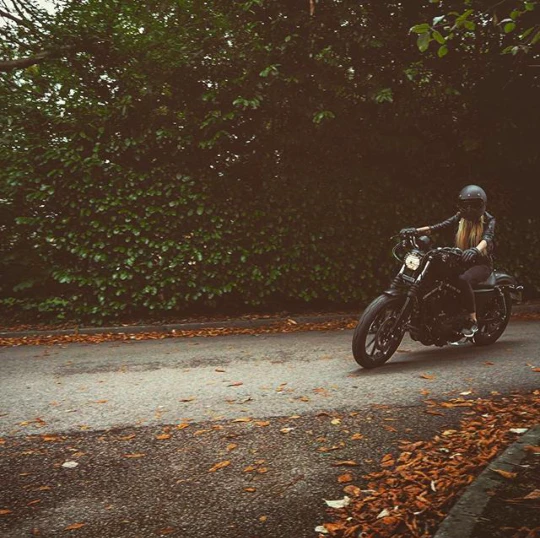back to the blog
How to Deal With Poor Conditions - Rookie to Rider

Courtney S · February 28, 2020

Rookie to Rider Series by Courtney
The Rookie to Rider series is written by experienced rider Courtney, who first hand has faced the many challenges and fantastic experiences that two wheels has to offer. The series aims to help all riders improve their skills and get more out of life on two wheels.
The fourth part of the Rookie to Rider Series can be found below. Enjoy!
-----------------------------------
Let’s face it, unless you’re extremely lucky (or live in a certain part of the world) at some point you’re going to experience poor riding conditions on a motorcycle. Even if you choose to be a fair-weather rider, sometimes you just will get caught out by the elements. So, it’s worth knowing some do’s and don’ts of how to deal with it and keep yourself safe when the weather strikes.
Wet
If you’re a commuter biker, then you will have dealt with plenty of wet rides on a motorbike! The best way to deal with the wet is to be prepared by already owning some great waterproof riding gear. Your waterproofs don’t have to cost a lot of money, but it’s always worth having them packed with you, ready to go in case you need to pull over mid-ride and do a quick change (been there!). Make sure you check the fit of your waterproofs too – they should cover up your ankles and wrists so you don’t end up getting wet inside your gloves or boots.
Another issue in the rain can be your visor: keep it clean, treat it with some anti-fog, and it will be fine.
Then, of course, you have the slippery roads to contend with, so:
- Be careful when braking, especially on the stretch before the traffic lights or anywhere you see shine or foam on the tarmac.
- As with dry conditions, always avoid riding over the white lines and drains on the road.
- Be sure to use both front and back brakes. Progressively squeeze the brakes to slow down or stop – don’t grab too hard, and give yourself greater stopping distances than usual. You may also find you don’t want to lean quite as far into your turns as usual; but in fact, leaning is still fine as long as you keep your body relaxed and keep up the revs.
In general, while riding in the wet and dealing with any sliding, the number one thing you can do to keep yourself safe is to keep your body relaxed – and upright!
Dark / Mist
Some country roads and rural areas can be extremely dark and foggy, especially at night. You have your lights on of course, yet sometimes it can still be hard to see. Focus on the white lines and stripes to help you see where you are on the road. Remember other road users will have their lights on as well, so you should still have notice of oncoming traffic even around corners. Just be sure to check your mirrors a little more often than usual to be extra-aware of what’s going on around you.
Wind
Just like in the wet, keeping your body relaxed is vital to riding in the wind. It will feel counterintuitive as you’ll naturally want to lock up and become rigid when battling against strong winds, but if anything this will cause you to jerk and effect the steering even further. So loosen up and trust that the bike will ride straight.
If the winds and storm get excessive to the point where you’re struggling to even hold the bike upright while at the traffic lights, then best get yourself home as soon and as safely as possible.
Cold / Snow
Ideally you would probably never ride in the snow. But if you’re caught out, then it’s best to keep well away from other traffic that may not have any traction or control on the road themselves. Here are a few more pointers:
- Much like riding in other poor conditions, keep your body relaxed.
- Ride slowly.
- Ride in a higher gear than usual.
- Do one thing at a time, e.g. brake, and then steer.
- Never brake in a corner.
Like with a bad storm, it’s probably best to get yourself home if caught riding in the snow.
That being said, cold weather shouldn’t ever have to stop you from riding completely, provided that you’re prepared. Cold, numb hands and feet can be dangerous to a rider – so help protect against the cold with thermals, layers and inners. If that’s still not enough, try heated gloves and jackets to keep yourself warm throughout the winter months.
Dealing with poor weather is an inevitable part of riding a motorcycle. And yet, being out in nature with the elements is just one great thing that sets you apart from other vehicles on the road. Just always ride safe, be prepared and enjoy it! Besides, all that wind and rain will make you a far better rider in the long run.
If you want to develop your riding skills even further, try checking out an advanced riding course or book your full licence.
Read more of the Rookie to Rider Series by Courtney:
How to improve your clutch control - Rookie to Rider 1 by Courtney
How to change gears on a motorbike - Rookie to Rider 2 by Courtney
How I learnt to corner better - Rookie to Rider 3 by Courtney


